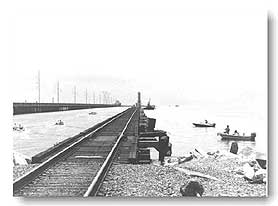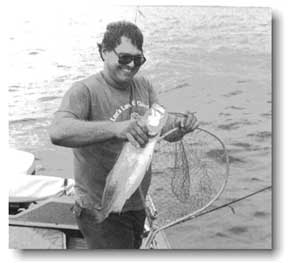The Lake Pontchartrain Trestle
The Lake Pontchartrain Trestle
By Jerry LaBella
Webster's dictionary defines trestles as: "A framework of vertical or slanting uprights and crosspieces, supporting a bridge, etc." And that, my friend, is exactly what you'll find running across the eastern side of Lake Pontchartrain from north (Slidell, Louisiana) to the south shore; spanning the five mile saltwater gap to accommodate train traffic for Southern Pacific.
Actually, the bridge network seems to have benefited the fishing community more than the railroad company. It can correctly be termed the back-porch fishing grounds for New Orleanians.
 Three bridges make the bridge link from south to north shore in this area, and they basically parallel each other. The La. Hwy. 11 bridge is situated in between the infamous Twin Span (I-10 bridge), to the east, and the Southern R. R. bridge (the Trestles), to the west. The distance from the business district to the north shore point is approximately 18 miles and is approachable via I-10 east to La. Hwy. 11.
Three bridges make the bridge link from south to north shore in this area, and they basically parallel each other. The La. Hwy. 11 bridge is situated in between the infamous Twin Span (I-10 bridge), to the east, and the Southern R. R. bridge (the Trestles), to the west. The distance from the business district to the north shore point is approximately 18 miles and is approachable via I-10 east to La. Hwy. 11.
Any fishing fanatic who has ever traveled across the La. Hwy. l 1 bridge and witnessed the calm beauty of green saltwater lapping against barnacle-covered pilings, has given second thoughts of detouring to Gilbert Cousin's or Tite's Place–notable access fishing marinas on the north shore.
These two places have been synonymous with the Trestles for over half a century and have satisfied the burning agony of summer fishing fever for countless numbers. The best part about it, you don't need a boat of your own to satisfy the craving, nor drive hundreds of miles from New Orleans.
Since these bridges naturally connect land points accessible by vehicle, this doesn't mean you can fish from any of these bridges, particularly the Trestles, which is consistently traveled by fast moving freight trains. The others are dangerous enough to drive on, let alone fish from. However, both marinas can provide you with a boat and/or motor, life preservers, and necessary tackle for a nominal fee. The advice, of course, on the how, when and where are free.
It is quite obvious why the Trestles are so productive, being they are wooden pilings placed in position over 100 years ago, according to Mr. Gilbert Cousins. Structure like this harbors abundant crustaceans and bait fish which are funneled and drawn to this five-mile shelter on moving tides. Lake Pontchartrain is the largest lake in the state, measuring approximately 40 miles wide and 24 miles long. This huge body of saltwater flows on ebbing or incoming tides through this five mile span which the Trestles cross.
According to Mr. Gilbert, "all sorts of saltwater fish are caught–flounder, reds, drum, trout, croakers and sheepshead," but added, "most are sheepshead and speckled trout." This area is visited mostly for its trout fishing from spring through fall and are successfully taken by a variety of methods.
"It all depends on the water ," Mr. Gilbert stated. "When the water is hot in the summer months, the fish are near the surface, not on the bottom." Most fishermen like to use a sliding cork to locate fish during the hotter seasons. This method allows the bait to be fished from near surface to bottom and allows for trouble-free casts. The average depth near mid vicinity of the Trestles is 10 to 15 feet. Live shrimp is the favorite bait, and they are readily available at either marina from late May through late October.
Some fishermen prefer trolling along the trestles with the use of lead core line (18-27 lb.) and MirrOlures (52 series) or Queen and King Bingos, according to Mr. Gilbert. Trolling is very effective if you want to offer the bait near the bottom when the speckled trout are deep. A three foot 15-20 lb. mono leader attached with a swivel to the lead line and a small snap swivel to the leader end will allow quick change out of lures. But, there's a bit more to it than just getting lead core line and a few lures and trolling them through the water. The main thing is the how-to.
The trick is to keeping the lure near the bottom without losing it. Basically, the length of the line and boat speed is what determines trolling depth. Actually, it is not as complicated as it might seem. However, it may cost you a lure or two at first, but once you get the hang of it, you're set.
Lead core line is conveniently color marked in different shades every 15 ft. So, you need to let out approximately two and a half colors which will put you near bottom when trolling this area. Of course, this also depends on your engine’s idle speed. In the event idle speed is too high for a trolling pace, you can slow the boat down by letting out two empty 5 gal. buckets, tied by means of a rope, to the stern of your boat. This method is much cheaper than buying a sea anchor and is just as effective for slowing the boats speed.
Fishing the Trestles with lead-core line requires getting the lure just off the bottom where the fish like to hang. To accomplish this, slowly feed line out, with the pole is in a rodholder, until the tip of the rod bounces back and forth. This indicates that you’re on the bottom. Next, gradually reel up the line until the rod tip just starts to stop bouncing. Once this has been accomplished, mark your line just ahead of the reel with the use of a rubber band tied in a single regular knot and trim the tag ends. If you stay trolling in that depth of water each trip, you simply let the line back out to your marked spot, and you are back in business.
As far as the color lure to use, Mr. Gilbert recommends orange or chartreuse when the water has good visibility. However, if the water is murky, pink colored ones are recommended.
Here’s an area, with its noisy train traffic and loud horn blasts, that’s unmistakably industrialized. But Mr. Gilbert remembers the time when only train noises drowned out conversation aboard the fishing boats and around the marinas.
With a beaming face, Mr. Gilbert recalled his childhood days– back when there was no such thing as an outboard motor engine– how he used to go out in his humble rowboat and would load up on bull croakers, " as much as you could stand to catch." Those were the days, he reminisced, when you could sell them for three cents a pound and make more money than the grown men working in the shipyard.
Dexter, at Tite's Place, said sheepsheads can also be caught under the trestles with the use of live shrimp, or grass shrimp in the winter, fished with a Carolina rig. However, he claims sheepshead strike the shrimp’s head first and if not properly placed on the hook you will just be feeding them. His fool-proof method is one that requires the breaking off the shrimp's tail section and passing a 1/0 hook through it until it exits the head. This way the hook gets eaten first, and you won’t lose the fish.
 "Start from the third, to maybe eight past the draw," Dexter added, with regard to good speckled trout fishing territory along this wooden-legged reef. But if you’re not familiar with Trestle-lingo, you might feel the need for an interpreter. To the regulars, however, this refers to the firebreaks and drawbridge locations along the Trestle’s route for fishing spot identification purposes. The firebreaks are distinguished by their concrete makeup and are placed in various sections to prevent total devastation of the entire Trestles in the event of a fire.
"Start from the third, to maybe eight past the draw," Dexter added, with regard to good speckled trout fishing territory along this wooden-legged reef. But if you’re not familiar with Trestle-lingo, you might feel the need for an interpreter. To the regulars, however, this refers to the firebreaks and drawbridge locations along the Trestle’s route for fishing spot identification purposes. The firebreaks are distinguished by their concrete makeup and are placed in various sections to prevent total devastation of the entire Trestles in the event of a fire.
Nevertheless, the Lake Pontchartrain Trestles prove to be the back-porch fishing grounds to New Orleanians.
Up-to-date fishing reports of the Trestles can be obtained by calling Gilbert Cousin's or Tite's Place: 1-985-649-4339.
|
